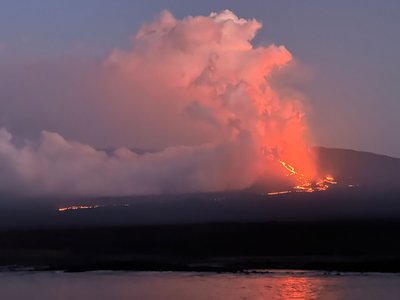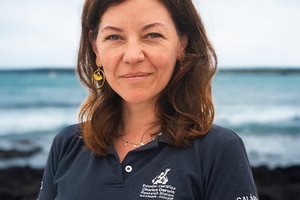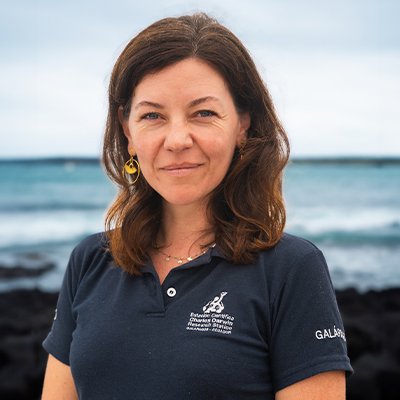Fernandina began what is likely to be a large eruption on the Volcano La Cumbre on Saturday, March 2nd, 2024, just before midnight. The previous eruption was in 2020, shortly before the pandemic disrupted everyone’s lives. We spoke to Dennis Geist, Professor Emeritus of geology at the University of Idaho who is specialized in the study of volcanoes and volcanic rocks, especially in the Galapagos Islands and the inland northwest of the United States. Dennis is also Chairman of Friends of the Charles Darwin Foundation, our fiscal sponsor and charity partner in the United States.

Dennis, tell us a bit more about this 2024 eruption, did we know it was coming?
On average, Fernandina erupts every 4-5 years, and the volcano has been entirely resurfaced with lava over the past 5,000 years so this is event is not a surprise. In addition to the short intervals between Fernandina eruptions, this activity was fully expected, because the volcano has been swelling due to the intrusion of magma since the 2020 eruption.
Currently, the 2024 eruption is from a circumferential fissure, near the summit of the volcano and parallel to the caldera wall. Because Fernandina is uninhabited and the volcano is not emitting much ash, there is little worry about hazards to humans. The main hazard will be gases, but currently the gas plume is not drifting towards inhabited areas. In addition to gases dissolved in the magma, when lava hits the ocean, hydrochloric acid is produced and these secondary gases (called VOG – volcanic fog) can be disruptive and dangerous.
Fernandina has erupted explosively in the past (most notably 1968), and explosive activity remains a possibility if the eruption shifts to the caldera due to interaction of magma with the caldera lake.
How does the frequency of Fernandina's eruptions compare to other volcanoes in the archipelago / region?
Fernandina erupts more often than all the other volcanoes in the archipelago put together. In other words, it has accounted for more than 50% of all eruptions. It is so active because it lies directly above the Galapagos mantle plume, at the leading edge of the hotspot.


How does the current eruption compare to previous ones in terms of scale and impact?
Most eruptions from Fernandina last only a few days, but others (e.g. 1995) last for over a month. It appears that the current eruption is more intense than average, but it is not particularly unusual.
What would happen if the volcano were to erupt explosively again? What’s the difference with its eruption now?
When magma encounters shallow water or groundwater, it tends to explode from the catastrophic conversion of water to steam (one tablespoon of water is instantly converted to 5 gallons of steam). Several volcanoes in the western Galapagos contain lakes in their calderas, including Fernandina. In 1968, an eruption through Fernandina’s crater lake was hugely explosive: the northwestern quadrant of the volcano was covered with explosively emplaced volcanic ash, and virtually all life was scrubbed from the caldera and the region covered by ash. The plume of gas and ash went into the stratosphere >20 km high.
As far as we know, the current eruption is solely outside the caldera. Care must be taken, however, because the eruptive vents can migrate, and it would not be surprising if the current eruptive fissure migrated to the caldera. I would not go onshore the island at this point, owing to the possibility of explosive magma-water interaction.
Are there any historical patterns or trends in Fernandina's eruptions that researchers are studying?
Fernandina is the best-studied volcano in the archipelago, owing to its activity. Satellite radar and GPS measurements are used to measure pre-eruptive inflation. Intrusion of magma into the guts of the volcano causes its surface to swell 10s of centimeters before an eruption. The Instituto Geofisico and Andy Bell (Edinburgh University) recently installed a network of seismometers to measure earthquakes related to magma migration.
How might the current volcanic eruption on Fernandina impact the unique biodiversity and ecosystems on the island?
All of the organisms on Fernandina evolved in the presence of regular volcanic eruptions, so this eruption is just part of the natural system. That said, we know that eruptions can cause local extinctions or extreme genetic bottlenecks. Lava and ash basically sterilize any ground it covers: once it cools, the new surface is a blank template for colonization. The main worry in Galapagos is that an eruption might endanger populations that have already been decimated by human activity or introduced species - not so natural processes. Fernandina is a carefully managed wilderness island, so human impacts are minimal.
How excited are you about this latest eruption?
Volcanic eruptions in the Galapagos are like children - I get excited over every new one. Each eruption teaches us a bit more about how the Earth works and a lot about the diverse behavior of Galapagos volcanoes.
For information on the eruption and technical appraisals, please see updates from the website of the Instituto Geofisico at https://igepn.edu.ec.








